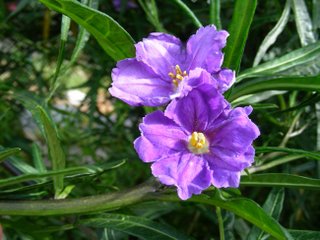For years, I've thought that the kangaroo apple dominating my back garden was Solanum laciniatum. But I'm notoriously bad at plant identification, so it really didn't surprise me when I found out that it could well be the closely-related S. aviculare.
 Even real botanists get the two species confused. The only readily observable difference between them is in the colour of mature fruit. That of S. aviculare is ripe when it turns from green to orange. The fruit of S. laciniatum either remains green or pales to yellow-orange. Subtle differences, indeed.
Even real botanists get the two species confused. The only readily observable difference between them is in the colour of mature fruit. That of S. aviculare is ripe when it turns from green to orange. The fruit of S. laciniatum either remains green or pales to yellow-orange. Subtle differences, indeed.Solanum aviculare occurs along the east coast of Australia, the New Guinea highlands and New Zealand. (It was described in 1786 from specimens collected earlier at Queen Charlotte Sound on Cook's second voyage down under.) Solanum laciniatum has a similar range and history. No wonder they're difficult to tell apart!
Odd things have happened in the evolution of S. aviculare and its closest relatives—S. laciniatum and the New Guinea endemic S. multivenosum. It's all to do with the number of chromosomes.
Most species have two sets of chromosomes—one set from each parent. This condition is called diploidy and is the 'normal' state. Solanum aviculare is a diploid species. But the other two are tetraploid: they have four sets of chromosomes.
 It's been suggested that this condition has resulted from hybridisation between S. aviculare and the south-eastern Australian S. vescum, another diploid species. Although such hybrids inherit a single set of chromosomes from each parent (in this example, one set from S. aviculare and one from S. vescum), these chromosomes don't match up. This causes problems with reproduction—they can't divvy up the chromosomes properly to pass on to the next generation—so the two sets of chromosomes double in number. Each chromosome now has a partner to pass on.
It's been suggested that this condition has resulted from hybridisation between S. aviculare and the south-eastern Australian S. vescum, another diploid species. Although such hybrids inherit a single set of chromosomes from each parent (in this example, one set from S. aviculare and one from S. vescum), these chromosomes don't match up. This causes problems with reproduction—they can't divvy up the chromosomes properly to pass on to the next generation—so the two sets of chromosomes double in number. Each chromosome now has a partner to pass on. It is also possible that the tetraploid species arose from spontaneous doubling of the normal chromosome complement. No inter-species shenanigans. It just happened.
Both scenarios are plausible. What we need now is a gel jock to sort out the conundrum.